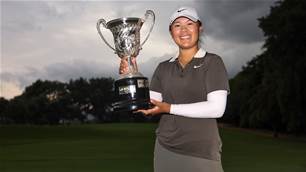What lessons might there be for golf – and the role of women in the game – from the extraordinary success of the Women’s T20 World Cup?
Like last year’s FIFA Women’s World Cup, the event seemed to grab the imagination of the sporting public and the capacity MCG Crowd who turned out to watch.
Despite being only a casual observer of any sport outside of golf, even I have noticed the increasing profile and popularity of women’s soccer, cricket and AFL in particular.
But as was pointed out in a Twitter discussion earlier today, women’s golf doesn’t seem to be benefitting from this wave of broader increased interest.
"Like any of the multitude of issues facing golf there are several other factors at play and no silver bullet to fix them."
There are no doubt a number of factors at play, some related to gender and some simply to do with golf, but here are a couple worth considering:
Golf, like tennis, is starting from a much higher base than most other sports in terms of professional women’s play.
The LPGA was founded in the 1950’s and since the 1970’s it would be fair to say it has been possible, as a woman, to make a living playing the game professionally.
(Men’s golf remains much more lucrative, of course, but that is a separate discussion.)
The second issue is one that likely effects golf across the gender divide and that is its perceived place within sport more generally.
With no body contact and little in the way of sweating or obvious physical exertion, many people – both men and women – don’t actually consider golf to be a sport.
It’s one of the reasons modern professional golf and golfers are so keen to push a narrative about fitness and strength training and its contribution to the power game.
You don’t have to go far in golf media to find some reference to Brooks Koepka more resembling an ‘NFL linebacker’ than a golfer.
This focus on physical strength – which is also present though less so among elite women players – is a relatively recent development and shifts the focus from golf’s more nuanced skill set to a more ‘football’ like mentality.
Whereas Seve Ballesteros was revered for his incredible prowess around the greens as much as his powerful driving, it is the latter which garners the lion’s share of attention in this millennium.
In a broader push for more women and girls to be more involved in sport the image of golf as being something ‘less’ in terms of a physical activity likely makes these issues around attracting new players more acute.
Put simply, cricket and football and the AFLW and Women’s Rugby League are seen as ‘proper’ sports; golf is not.
Like any of the multitude of issues facing golf there are several other factors at play and no silver bullet to fix them.
However, if one is searching for a light on the horizon look no further than South Korea where women’s professional golf is more popular than the men’s equivalent.
That’s not true of any of the mainstream sports, so in many ways golf actually has an advantage.
Now the game just needs to figure out how to make the most of it.
Related Articles

Teenager Anna Huang makes history with La Sella Open triumph

Winner’s Bag: Jeeno Thitikul – CME Group Tour Championship













